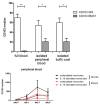Up-regulation of CD163 expression in subpopulations of blood monocytes after kidney allograft transplantation
- PMID: 32901498
- PMCID: PMC8549908
- DOI: 10.33549/physiolres.934531
Up-regulation of CD163 expression in subpopulations of blood monocytes after kidney allograft transplantation
Abstract
M2 macrophages expressing CD163 are known to suppress immune responses but have been also found in biopsies of patients with chronic kidney allograft injury associated with interstitial fibrosis. The aim of our study was to evaluate the expression of CD163 in blood monocytes, precursors of tissue macrophages, in kidney allograft recipients with uncomplicated outcome (n=94) compared with those developing acute rejection (n=44). Blood samples were collected before the transplantation and at 1 week, 1 month and 1 year. The expression of CD163 increased during the first week after the transplantation not only in classical (CD14+CD16-) but also in intermediate (CD14+CD16+) and nonclassical (CD14lowCD16+) monocytes in all patients regardless of their rejection status. In patients developing acute rejection, higher pre-transplant expression of CD163 on blood monocytes was found. In vitro experiments confirmed strong induction of membrane CD163 on monocytes together with CD206 (an alternative marker of M2 macrophages) in response to IL-10. We assume from our data that dramatic upregulation of CD163 by peripheral blood monocytes may have a pathophysiological role in early phases after kidney allograft transplantation and high pre-transplant expression of CD163 on blood monocytes might be involved in events leading to acute rejection.
Conflict of interest statement
There is no conflict of interest.
Figures






Similar articles
-
CD14+CD16+ and CD14+CD163+ monocyte subpopulations in kidney allograft transplantation.BMC Immunol. 2014 Feb 6;15:4. doi: 10.1186/1471-2172-15-4. BMC Immunol. 2014. PMID: 24499053 Free PMC article.
-
Monocyte implication in renal allograft dysfunction.Clin Exp Immunol. 2014 Feb;175(2):323-31. doi: 10.1111/cei.12228. Clin Exp Immunol. 2014. PMID: 24134783 Free PMC article.
-
CD163 as a Potential Biomarker of Monocyte Activation in Ischemic Stroke Patients.Int J Mol Sci. 2021 Jun 23;22(13):6712. doi: 10.3390/ijms22136712. Int J Mol Sci. 2021. PMID: 34201498 Free PMC article.
-
Soluble CD163 is a potential biomarker in systemic sclerosis.Expert Rev Mol Diagn. 2019 Mar;19(3):197-199. doi: 10.1080/14737159.2019.1571911. Epub 2019 Jan 22. Expert Rev Mol Diagn. 2019. PMID: 30657715 Review. No abstract available.
-
CD163: a regulated hemoglobin scavenger receptor with a role in the anti-inflammatory response.Ann Med. 2004;36(5):347-54. doi: 10.1080/07853890410033171. Ann Med. 2004. PMID: 15478309 Review.
Cited by
-
M1/M2 macrophages and their overlaps - myth or reality?Clin Sci (Lond). 2023 Aug 14;137(15):1067-1093. doi: 10.1042/CS20220531. Clin Sci (Lond). 2023. PMID: 37530555 Free PMC article.
-
Changes in phenotypic patterns of blood monocytes after kidney transplantation and during acute rejection.Physiol Res. 2021 Nov 29;70(5):709-721. doi: 10.33549/physiolres.934700. Epub 2021 Sep 10. Physiol Res. 2021. PMID: 34505523 Free PMC article.
-
Multiplexed droplet single-cell sequencing (Mux-Seq) of normal and transplant kidney.Am J Transplant. 2022 Mar;22(3):876-885. doi: 10.1111/ajt.16871. Epub 2021 Dec 4. Am J Transplant. 2022. PMID: 34687145 Free PMC article.
References
-
- AKAHORI H, KARMALI V, POLAVARAPU R, LYLE AN, WEISS D, SHIN E, HUSAIN A, NAQVI N, Van DAM R, HABIB A, CHOI CU, KING AL, PACHURA K, TAYLOR WR, LEFER DJ, FINN AV. CD163 interacts with TWEAK to regulate tissue regeneration after ischaemic injury. Nat Commun. 2015;6:7792. doi: 10.1038/ncomms8792. - DOI - PMC - PubMed
-
- CINKAJZLOVA A, LACINOVÁ Z, KLOUČKOVÁ J, KAVÁLKOVÁ P, TRACHTA M, KOSÁK M, KRÁTKÝ J, KASALICKÝ M, DOLEŽALOVÁ K, MRÁZ M, HALUZÍK M. An alternatively activated macrophage marker CD163 in severely obese patients: the influence of very low-calorie diet and bariatric surgery. Physiol Res. 2017;66:641–652. doi: 10.33549/physiolres.933522. - DOI - PubMed
-
- DESY O, BELAND S, VALLIN P, RIOPEL J, LATULIPPE E, NAJAFIAN N, CHANDRAKER A, AGHARAZII M, BATAL I, De SERRES SA. IL-6 production by monocytes is associated with graft function decline in patients with borderline changes suspicious for acute T-cell-mediated rejection: a pilot study. Transpl Int. 2018;31:92–101. doi: 10.1111/tri.13070. - DOI - PubMed
MeSH terms
Substances
LinkOut - more resources
Full Text Sources
Medical
Research Materials
